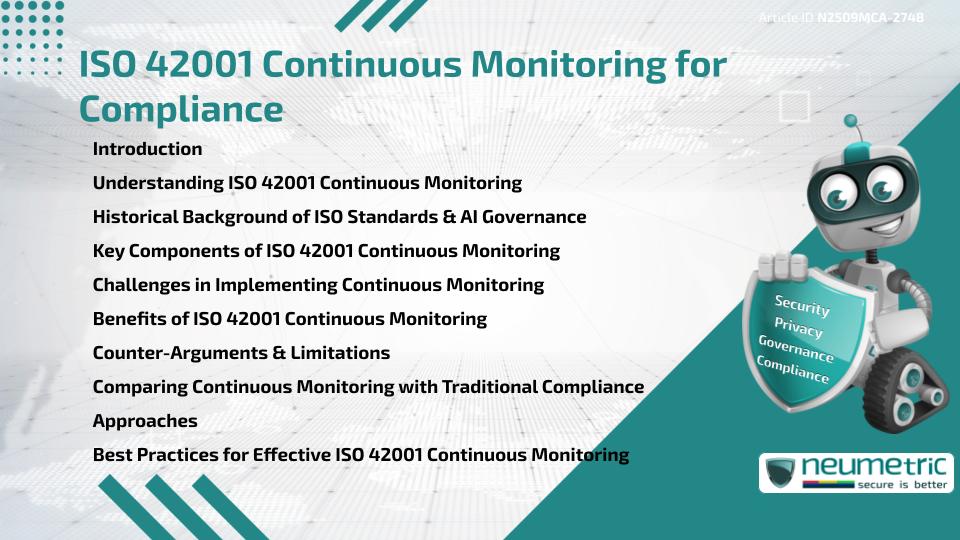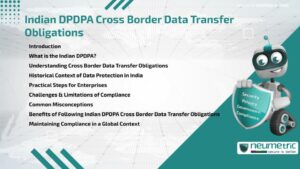Table of Contents
ToggleIntroduction
The ISO 42001 Continuous Monitoring approach provides Organisations with a Framework to ensure ongoing compliance in managing Artificial Intelligence [AI] systems. Unlike one-time audits, Continuous Monitoring under ISO 42001 emphasizes real-time oversight, proactive Risk Management & consistent performance evaluation. Adopting ISO 42001 Continuous Monitoring enables Organisations to identify issues early, protect Data Integrity & maintain trust in AI-driven Processes.
Understanding ISO 42001 Continuous Monitoring
The ISO 42001 Continuous Monitoring concept focuses on tracking compliance across all stages of AI System use. It involves integrating Monitoring Tools, defining measurable indicators & aligning oversight with organizational objectives. For Organisations, this approach transforms compliance from a static requirement into a dynamic & adaptive process that evolves with business & regulatory changes.
Historical Background of ISO Standards & AI Governance
The International organisation for Standardization [ISO] has long provided global frameworks such as ISO 9001 for Quality Management & ISO 27001 for Information Security. ISO 42001 extends this tradition into the realm of AI, addressing Governance, accountability & ethical use. Continuous Monitoring became a central feature of ISO 42001 to address the rapid pace of technological change & the Risks associated with autonomous systems.
Key Components of ISO 42001 Continuous Monitoring
Effective ISO 42001 Continuous Monitoring consists of several core components:
- Performance metrics: Tracking operational efficiency, accuracy & fairness of AI Systems.
- Risk detection: Identifying Vulnerabilities, including bias, security Risks & compliance gaps.
- Data Integrity controls: Ensuring that datasets remain accurate, secure & relevant.
- Automated Monitoring Tools: Using AI-driven solutions for real-time compliance tracking.
- Documentation & reporting: Maintaining clear records for audits & regulatory oversight.
- Feedback Loops: Regularly updating AI Systems & Policies based on monitoring results.
Challenges in Implementing Continuous Monitoring
Organisations face several challenges in applying ISO 42001 Continuous Monitoring. These include high costs for implementing advanced Monitoring Tools, integration difficulties across legacy systems & the need for skilled staff to interpret results. Smaller businesses may find it especially difficult to balance resources while maintaining effective oversight.
Benefits of ISO 42001 Continuous Monitoring
Despite challenges, iso 42001 Continuous Monitoring offers significant benefits:
- Provides real-time visibility into AI System performance.
- Enhances accountability by documenting compliance activities.
- Improves Data Security & reduces the Likelihood of breaches.
- Builds trust with Stakeholders by demonstrating proactive oversight.
- Enables Organisations to respond quickly to regulatory changes.
Counter-Arguments & Limitations
Critics argue that Continuous Monitoring may overwhelm Organisations with excessive data & alerts, leading to “compliance fatigue.” Others suggest that automation cannot fully replace human judgment in evaluating ethical implications. While these limitations exist, a balanced approach that combines automated monitoring with expert oversight addresses these concerns effectively.
Comparing Continuous Monitoring with Traditional Compliance Approaches
Traditional compliance methods often rely on periodic audits & static reporting. While useful, these methods may fail to capture evolving Risks. In contrast, iso 42001 Continuous Monitoring offers dynamic oversight, enabling Organisations to adapt in real time. This shift mirrors broader industry trends toward continuous auditing & proactive Risk Management.
Best Practices for Effective ISO 42001 Continuous Monitoring
Organisations can maximize the value of ISO 42001 Continuous Monitoring by:
- Defining clear monitoring objectives & metrics.
- Leveraging automation tools without neglecting human oversight.
- Conducting regular reviews of monitoring processes.
- Training staff on interpreting monitoring results & acting on insights.
- Embedding monitoring into organizational culture as an ongoing responsibility.
Conclusion
The ISO 42001 Continuous Monitoring Framework equips Organisations with a proactive approach to compliance in AI Systems. By combining real-time oversight with structured metrics, businesses can ensure accountability, manage Risks & maintain trust in their AI Operations.
Takeaways
- Iso 42001 Continuous Monitoring ensures dynamic oversight of AI Systems.
- It includes performance tracking, Risk detection & Data Integrity controls.
- Challenges include high costs & integration complexity.
- The benefits of real-time visibility & accountability outweigh the limitations.
FAQ
What is ISO 42001 Continuous Monitoring?
It is the ongoing process of tracking AI System compliance & performance under the ISO 42001 Framework.
How does Continuous Monitoring differ from traditional audits?
Continuous Monitoring provides real-time oversight, while traditional audits focus on periodic evaluations.
Why is Continuous Monitoring important for AI compliance?
It helps Organisations detect Risks early, maintain accountability & adapt to regulatory changes.
What tools support ISO 42001 Continuous Monitoring?
Tools include automated compliance software, AI-driven analytics & secure reporting systems.
Can small Organisations implement Continuous Monitoring effectively?
Yes, but they may need to adopt scaled approaches & prioritise critical monitoring areas.
Does Continuous Monitoring replace human oversight?
No, it complements human expertise by providing real-time insights that require expert interpretation.
References
- ISO – Artificial Intelligence Management System Standards
- NIST – AI Risk Management Framework
- OECD – AI Principles
- ISO – Standards & Certification Overview
- Council of Europe – Artificial Intelligence & Human Rights
Need help for Security, Privacy, Governance & VAPT?
Neumetric provides organisations the necessary help to achieve their Cybersecurity, Compliance, Governance, Privacy, Certifications & Pentesting needs.
Organisations & Businesses, specifically those which provide SaaS & AI Solutions in the Fintech, BFSI & other regulated sectors, usually need a Cybersecurity Partner for meeting & maintaining the ongoing Security & Privacy needs & requirements of their Enterprise Clients & Privacy conscious Customers.
SOC 2, ISO 27001, ISO 42001, NIST, HIPAA, HECVAT, EU GDPR are some of the Frameworks that are served by Fusion – a SaaS, multimodular, multitenant, centralised, automated, Cybersecurity & Compliance Management system.
Neumetric also provides Expert Services for technical security which covers VAPT for Web Applications, APIs, iOS & Android Mobile Apps, Security Testing for AWS & other Cloud Environments & Cloud Infrastructure & other similar scopes.
Reach out to us by Email or filling out the Contact Form…




